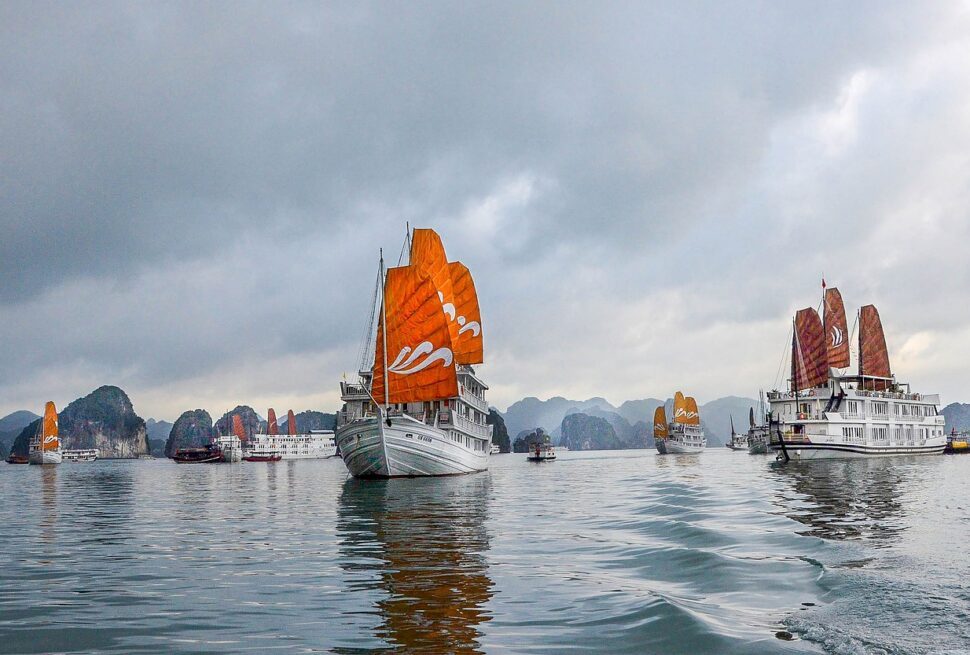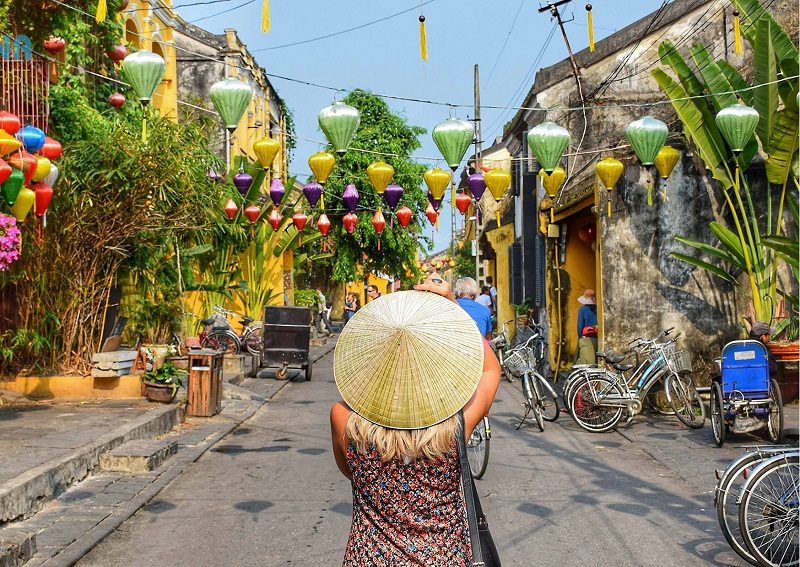
Vietnam, much like India, offers an overwhelming array of beauty and intricacy. Its landscapes are varied, featuring the mist-shrouded mountains of Sapa, the seemingly infinite flow of motorbikes in Hanoi, and the towering limestone formations of Ha Long Bay. I believe that travel serves as the greatest educator, and few places present a better opportunity to learn about world history than this Southeast Asian country.
Continue reading for comprehensive information on where to travel in Vietnam and how to prepare effectively for your journey! I suggest booking transfers via Klook for ease, and you can use 12go.asia for bus and train tickets if you prefer not to visit the station for in-person purchases. Be sure to read reviews prior to making reservations.
Northern Vietnam
1. Ha Long Bay and Lan Ha Bay
Ha Long Bay, a UNESCO World Heritage site, is one of those destinations, much like Machu Picchu, that you simply must see at least once during your lifetime. The views are utterly breathtaking: soaring limestone cliffs and over 1,100 islands dispersed across the emerald waters of the Gulf of Tonkin. It stands as Vietnam’s premier attraction. Experiencing the bay is best done through a multi-day cruise on a houseboat, allowing you to explore the islands, swim, and indulge in an abundance of fresh seafood! Day trips and overnight excursions cater to all budgets, but I recommend spending a night or two on a houseboat!
Ha Long Bay vs Lan Ha Bay
Historically, Ha Long Bay extended over two provinces and was divided into sections managed by two distinct local authorities—Ha Long Bay in the north and Lan Ha Bay in the south, adjacent to Cat Ba Island. (Both bays fall under the UNESCO designation.) More than 300 vessels operate in Ha Long Bay, which is particularly popular among Chinese tourists, while only 64 boats are active in Lan Ha Bay, according to my local guide during a recent visit.
Though both bays showcase similar scenery, Lan Ha Bay experiences less pollution and fewer tourists but offers limited infrastructure, which I have observed on my trips to both. There are no caves in Lan Ha Bay or scenic viewpoints like the one in my photograph from Ha Long Bay. The caves are among the remarkable features in the UNESCO nomination. While the caves are magnificent, they tend to become quite crowded.
Although it’s feasible to secure last-minute budget tours on Klook or GetYourGuide, luxury vessels, such as the Ginger by Heritage Line (a beautiful ship I experienced during a work trip), tend to fill up four months in advance. For a visit to both bays, consider booking separate consecutive one-night trips on different boats. (Only a few boats that maintain good relations with the government are permitted to operate in both bays.)
When to Visit Ha Long Bay & Lan Ha Bay
To enjoy clear skies, plan your visit between April and October. From June to August, the weather can be sweltering but less crowded. November to March brings cooler temperatures (with highs in the 60s in January) but often features persistent gray skies. September to October is bustling with tourists. My visits have primarily taken place in January or July, and I prefer July for its blue skies.
How to Get to Ha Long Bay
Most visitors arrive at Hanoi’s Noi Bai International Airport, the country’s second-largest airport, before arranging transfers. (There are two smaller airports close to Ha Long Bay—Van Don International and Cat Bi International.) If your boat tour doesn’t provide a transfer, you can find reasonable transportation options through Klook. The drive typically takes about three hours.
2. Ninh Binh
Ninh Binh province is often referred to as “Ha Long Bay on land” and is renowned for its rowboat experiences through vast caves and along impressive limestone formations. The most breathtaking boat excursion is at Trang An (Route 3), which offers a three-hour journey through stunning landscapes and the long Hang Dot cave.
During the wet season when the rice fields are lush, Tam Coc presents a beautiful 1.5-hour boat ride where local guides row using their feet, but if you can only choose one, Trang An is the superior option. The view from Mua Cave is definitely worth the climb up 500 stairs, especially when the rice fields are at their greenest. Other sites I enjoy include the charming Bich Dong Pagoda and cave temple (which has free entry) and Bai Dinh Pagoda, an Instagram-worthy 4,200-acre Buddhist complex that ranks among the largest in Southeast Asia and can be easily navigated using an electric cart shuttle.
In Ninh Binh City, Hoa Lu Old Town is a remarkable sight, featuring two towering modern pagodas beautifully illuminated at night alongside intricate carvings inside. This is a free attraction constructed in 2022, distinct from Hoa Lu Ancient Town, the historic site of Vietnam’s first capital located 11 kilometers away.
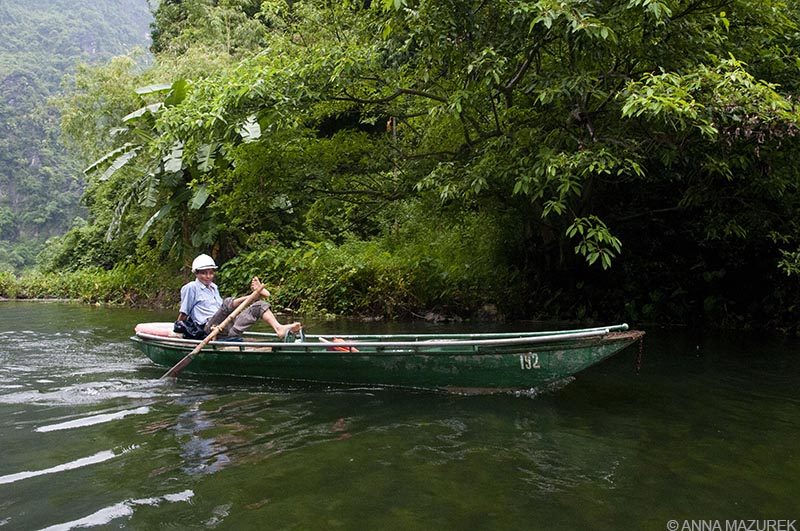
Tam Coc serves as an excellent base for exploring the region. In January 2025, I stayed at Tam Coc Mountain Sunset and Garden Hotel ($30 USD/night), which had spacious rooms and a prime location, complete with a pool and a friendly, English-speaking owner. I suggest spending a few nights here, although there are plenty of day tours from Hanoi if your time is limited.
How to Get to Ninh Binh Province
Ninh Binh province is situated approximately an hour and 45 minutes southeast of Hanoi. The most economical choice for transportation is public buses from Hanoi. Recently, I utilized a $7 shared transfer service from Hanoi, which was quite efficient and required a change to an SUV that took me directly to my hotel.
3. Sapa
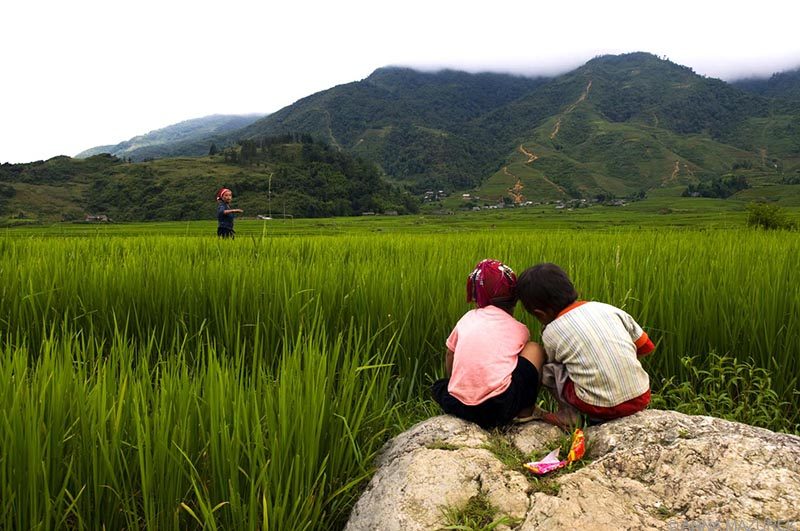
The former hill station from 1922 in France is now a trekking paradise in Vietnam. The views overlooking the valley from the town are breathtaking. (The image above is one of my all-time favorite photos taken during my years in Asia.)
Some well-known treks include Fansipan, which is Vietnam’s tallest mountain at 3,143 meters; Cat Cat, a village located three kilometers south of Sapa; Ta Phin Village, a hike that is 10 kilometers from the city; and Sa Seng & Hang Da, a trail along the eastern ridge that offers excellent views of the valley. Beware—the persistent tourist touts and aggressive sellers in Sapa can be overwhelming. (During my visit to a village with a student group, a vendor followed each student around town for the entire day trying to sell them something.) Nevertheless, the stunning scenery makes it a trip worth taking!
How to get to Sapa
Sapa is situated 195 miles northwest of Hanoi, which is the nearest airport, and is close to the China border. Traveling by car or bus takes about five to six hours, depending on traffic conditions. I have previously taken the roughly seven-hour sleeper train that runs from Hanoi to Lao Cai, which is the nearest station to Sapa. From there, it takes an extra 50-minute transfer to reach Sapa. There are also less expensive sleeper buses available for about half the cost of the train ($11-$16 USD).
4. Hanoi
Hanoi serves as the nation’s capital and is synonymous with chaos. The streets are packed with throngs of motorbikes. Find a secure place on the sidewalk to observe as these bikes defy logic and gravity with their cargo, which can range from refrigerators to a family of five along with a dog, and my personal favorite – numerous plastic bags filled with water and live goldfish secured to a large hoop structure on the back.
Explore the Old Quarter and the Hoan Kiem shopping district, where the streets are themed based on the products they offer. (This becomes quite frustrating if you’re in need of a pen while walking down the shoe street.) Pho bo (beef noodle soup) is essential for breakfast, accompanied by a classic Vietnamese coffee, which is a medium to coarse ground dark roast using a small metal drip filter.
For a delicious bánh mì, head to Banh Mi 25. The Note Cafe provides an Instagram-worthy experience, adorned from floor to ceiling with post-it notes, while JOMA is one of my favorite café chains in Southeast Asia for breakfast. For a thrilling experience, check out Hanoi 1990s, a quaint café situated on the edge of Hanoi’s renowned train street where trains pass by daily, just inches away from your table.
Take a leisurely walk around Hoàn Kiếm Lake and cross the red bridge leading to Ngoc Son Temple. Visit the Temple of Literature and the Ho Chi Minh Museum. If you’re interested in meeting “Uncle Ho,” stop by his mausoleum. Keep in mind – he is preserved and displayed in a typical communist style.
How to get to Hanoi
Hanoi hosts the second busiest airport in Vietnam and has convenient bus or train connections to major locations across the nation. Although Ho Chi Minh City offers more international flights, Hanoi remains easily accessible.
Central Vietnam
5. Hoi An
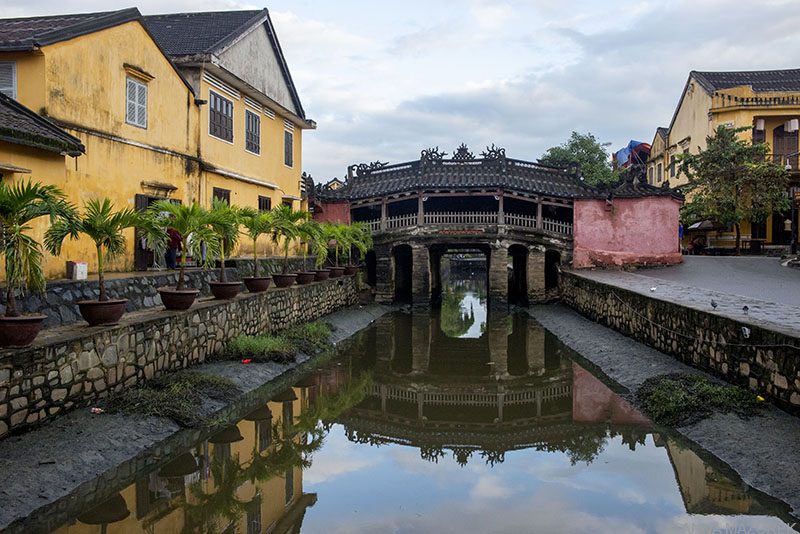
Hoi An is my top choice among cities in Vietnam. This UNESCO World Heritage site is one of the key seaports in Southeast Asia and reminds me somewhat of Charleston, with its charming historic atmosphere, colonial architecture, and a large number of tourists. Each morning, I woke up at sunrise to capture photographs of the city and repeated this at sunset. Notable attractions include the Japanese Covered Bridge, the Assembly Hall of the Cantonese Chinese Congregation featuring impressive dragon carvings, and the Assembly Hall of the Fujian Chinese Congregation.
The finest Banh Mi places in the area are Banh Mi Queen (I especially enjoyed the chicken!) and Banh Mi Phuong (which was a favorite of Anthony Bourdain). Streets Restaurant Café had the best Cau Lau I tried throughout my trip and also operates as a nonprofit that trains disadvantaged youth for careers in the culinary and hospitality industry.
Getting to Hoi An
An The nearest airport is Da Nang, located about a 30-minute drive away. I arranged a direct transfer from Da Nang to Hoi An via Klook for approximately $10, but there are even more affordable group transfer options available. It’s advisable to read reviews before making a booking!
Day Trips from Hoi An
Hoi An serves as an excellent base for several day trips, including a visit to My Son, which features the remnants of a Hindu temple complex. If you have a motorbike, you can explore it independently. Additionally, I highly recommend renting a bicycle to visit the coconut village and enjoy a boat ride on one of the circular boats. Although it’s quite a touristy activity, it is such an enjoyable experience.
6. Da Lat
Da Lat is often compared to Medellin in Vietnam. The French sought refuge in this hilly area to escape the heat. Today, it serves as the adventure hub—options like trekking, canyoning, white water rafting, and mountain biking abound. The atmosphere here is much more relaxed than in other parts of Vietnam, which I appreciated. I dedicated most of my time to exploring waterfalls. My favorite was Pongour, but you can’t miss the roller coaster at Datanla waterfall (it’s a fun, self-controlled one-car system!). I recommend visiting the Hang Nga Crazy House, designed by a Vietnamese architect who was inspired by Gaudi. You can tour it and even stay overnight! Don’t overlook the 100 Roofs Bar, which looks like something out of a Lord of the Rings film.

How to get to Da Lat
The nearest airport is Lien Khuong Airport, located about 18 miles south of the city. Sleeper buses operate from Hanoi (7 hours), while vans and buses connect Nha Trang (4 hours) and Mui Ne (5 hours). I took a long sleeper bus from Hoi An, which took 14 hours.
Southern Vietnam
7. Mui Ne

Mui Ne is known as Vietnam’s kitesurfing hub. While the beach in town isn’t the best, there are some exciting attractions nearby. For just $5, you can join a jeep tour to the red sand dunes close to town as well as the white sand dunes located 24 km away. These tours also include a visit to Fairy Spring, which features a stream flowing through unique rock formations and sand dunes. (It’s easily reachable on foot from the town.)
One of the top dining options in town is a Mediterranean restaurant named Sindbad and for a wider variety, Dong Vui Food Court offers an open-air setting with independently operated stalls serving everything from German sausages to paella. You’ll also find plenty of Vietnamese dishes and a wide selection of beer.
My main motivation for visiting Mui Ne was the Ke Ga Lighthouse, a secluded lighthouse constructed by the French in 1899 that sits on a rocky islet 300 meters offshore. I have a fascination with lighthouses, so it was a must-see for me. To reach the lighthouse, you’ll need either a scooter or a car, followed by a ferry ride to the island ($6 USD in 2019). During my visit, I mostly had the island to myself aside from a few officials who were working there.
For the most stunning shots of the lighthouse, take the dirt paths that veer off to the side and capture images of the lighthouse from behind. The lighthouse is adjacent to a fishing village, so the shoreline is dotted with boats to the right of the islet, which also makes for excellent photographs.
Getting to Mui Ne
I took a bus from Da Lat that took 5 hours, followed by another bus to Ho Chi Minh City that lasted 3 hours. There isn’t a train station in Mui Ne, and the nearest airport is located in Ho Chi Minh City. You can arrange group and private car transfers through Klook to Ho Chi Minh and other destinations.
8. Ho Chi Minh City (Saigon)
Ho Chi Minh City (HCMC) stands as a hub of motorbike activity. Spending a few days here is worthwhile just to experience the bustling atmosphere and to explore the war museum and other historical sites from the war period. Observing the city from the Bitexco Financial Tower ($9 USD) truly highlights the vastness of HCMC. (I recommend purchasing tickets in advance through Klook for your preferred time, as it’s the same price as buying at the venue and helps you avoid waiting in line.) Interestingly, HCMC is recognized as the craft beer capital of Southeast Asia. My top picks for breweries are Pasteur Street Brewing Company (which offers excellent IPAs and a great taproom) and Heart of Darkness. BiaCraft and Belgo (a Belgian brewery) also provide delicious beers and food.
My preferred cafes and sandwich shops include The Old Compass, L’Usine, The Vintage Emporium, and Banh Mi 3362. ABC Bakery Café is an excellent place for a quick and inexpensive breakfast on the go!
Au Lac Charner ($73/night plus taxes) is my preferred hotel featuring a rooftop pool in Ho Chi Minh City. It also provides free breakfast and is conveniently located near the Bitexco Financial Tower. If you’re interested in luxury, the Park Hyatt Saigon ($289) is the finest hotel in the area, boasting an incredible pool, gym, and an outstanding breakfast! (For work, I stay at the Park Hyatt, but I choose Au Lac Charner otherwise.)
How to get to Ho Chi Minh City
Getting to Ho Chi Minh City is straightforward as it hosts the busiest airport in Vietnam and serves as the primary transportation hub. From there, you have access to buses, vans, and trains to travel anywhere in Vietnam. Keep in mind that Hanoi and Ho Chi Minh City are located at opposite ends of the country, requiring a lengthy 30-hour train journey between them.
9. Cu Chi Tunnels
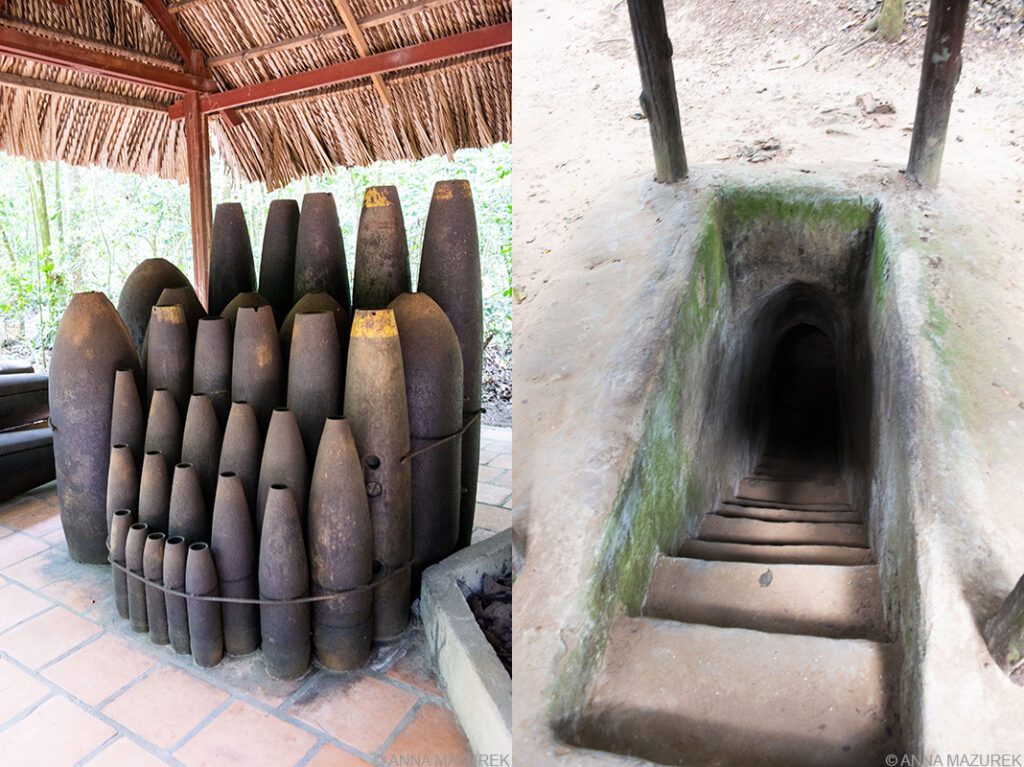
Cu Chi is a countryside region located approximately 30 to 40 kilometers from Ho Chi Minh City, known for its intricate network of tunnels used by the Viet Cong in the 1960s to manage the area. There are two tunnel sites: Ben Dinh and Ben Duoc. Ben Dinh is more popular among tourists since it’s easier for tour buses to access. In contrast, I prefer Ben Duoc because it’s less crowded. (Take my word for it; I’ve visited both!) When we went, there were only a few visitors. (We traveled by public bus from Ho Chi Minh City, and it turned out to be one of my favorite experiences in Vietnam. I wrote a post detailing how to reach the Ben Duoc tunnels by public bus.)
I’ve come across conflicting information stating that Ben Dinh was built solely for tourists, while Ben Duoc is a part of the actual tunnel network. However, I haven’t found a trustworthy source to confirm this. According to Lonely Planet, Ben Duoc was expanded for tourists but is less frequented. (There is a staircase leading into the tunnels, which clearly isn’t original. Honestly, both entrances were likely modified to some extent, but they remain quite small.)
How to get to the Cu Chi Tunnels
Although it’s easy to find tours to Ben Dinh, I suggest taking the air-conditioned public buses to Ben Duoc.
10. Mekong Delta

Can Tho serves as the central hub in the Mekong Delta, characterized by expansive gardens and lively markets. It is the ideal starting point for exploring the renowned Cai Rang Floating Market, the largest in the Delta. Vendors display their goods tied to poles, making it convenient for shopping. Additionally, there are boats offering coffee.
Although tours are available, I suggest arriving at the dock around 5 a.m. to secure your own boat at a good price. I went with a friend and encountered three friendly Australians who decided to join us. In 2019, we each paid roughly $4.30 USD for the ride. A memorable experience was visiting a fruit orchard, where we paddled in small boats and tasted various fruits. This town is unforgettable, especially because it led to an unexpected five-hour van ride alongside a rooster. I’m also quite fond of the market town of Chau Doc, which features a vibrant wet market that’s fantastic for photography.
How to get to Can Tho, Mekong Delta
Getting to Can Tho in the Mekong Delta is easy, as it takes about four hours by bus from Ho Chi Minh. Can Tho International Airport is situated only a few miles from the city.

